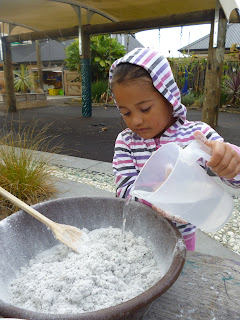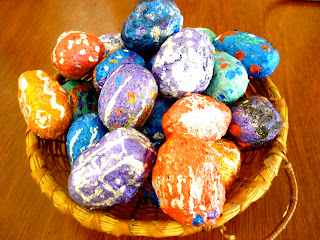Over the last couple of weeks the children have shown a strong interest
in fairy tales. They have been bringing in stories from home to share and
we have been digging out all the wonderful tales we can find at Kindergarten.
These stories are something that a lot of the children are already familiar with
as they read them at home with their families. Fairy tales capture children’s
imagination and keep them in suspense as the good characters (the likes of Snow White,
Little Red Riding Hood or Hansel and Gretel) deal with adversity and nasty
situations only to come out on top. Fairy tales are known for their scary
elements, which are all part of the moral values that they bring to the children’s
attention. These tales benefit children because they promote hopes and dreams, enhance vocabulary and worldly
knowledge, expand
imagination and creativity.
“Do not discount fairy tales as a bad influence on your children. Do not be
afraid of unleashing their imagination and letting them confront their darkest
fears. By giving them heroes to identify with, you are letting those fears
surface in a subtle manner, and allowing your child to find his courage and
make moral choices vicariously-choices that will build his character and have
influence on the rest of his life.” (Lakin)
One of the fairy tales that has become very popular amongst the
children has been the ‘Three Little Pigs and the Big Bad Wolf.” The book has
been read many times and we have also watched a Walt Disney Classic: Silly Symphony of the Three Little Pigs on YouTube. The
book and the short cartoon have brought so much joy and delight to the
children.
The children have
been using their knowledge of the book and the cartoon to support their play as
they revisit the story with their friends and teachers.
Kim had used the
small toy pigs , a wolf puppet and small blocks during a group time to tell the
story. William thought that this was great and absolutely loved watching the
story being played out. The following day he found all these same props and set
himself up on the mat.
“The pigs house blows down.”
(William)
Alex and Jammin
spent quite some time making their toy pigs houses just like in the story. They
shared what they knew with each other and this fostered and helped sustain
their game.
“You remember in the story
the wolf asks if he can come in but the pigs say no, so the wolf tricks them
and pretends to go home. He then comes back dressed as a sheep. Then the pigs
don’t believe him and this makes the wolf mad. So he huffs and he puffs and
blows the house down.” (Alex)
David and Pesiki
were engaged in a similar game and they used their knowledge of the Three
Little Pigs as a vehicle for their play.
“We are building a brick
house so the wolf doesn’t find him!” (David)
Leah captured the
interest of all these children when she was re-telling the story. The children
who were listening were so engaged and their reactions (especially Jammin’s) were
full of emotion.
“Children love to hear stories; a story told
well can communicate morals and important lessons, or afford a medium for your
children to explore feelings.” (Mork)
Makenzie, Leah
and Jessie-May have been doing a lot of talking about how they would like to do
a Three Little Pigs show. They had a meeting about this to discuss their plans
and ideas. Clip-boards and pens were essential to this meeting as they allowed for
the girls to take notes and draw plans. This was another way in which their
knowledge of the story could be revisited and reflected upon.
“We are having a conversation
meeting about our Three Little Pigs and the Big Bad Wolf show. We would like the
teachers to tell the story and we will act it. We are going to have the story
where all the pigs get safe in the brick house” (Jessie-May)
“The wolf is going to be
dressed up like a man to trick the pigs. I am drawing an angry smile for the
wolf because he is angry. I’m going to be the Big Bad Wolf in the show”
(Makenzie)
“I liked it in the story
when the wolf pulls the pigs tails. I’m trying to draw the fire thing that the
wolf goes down. My wolf is growling at the Little Pigs.” (Leah)
“When Makenzie is the wolf
she will grab on to the tails and then he falls backwards and bangs into the
apple tree. It will be funny. Now I have to concentrate on my running because I
am the stick pig and the wolf will be chasing us.” (Jessie-May)
These three also
happily got up at group time to show the rest of the children how the Three
Little Pigs sing and dance in the show.
“Who’s afraid of
the big bad wolf, the big bad wolf, the big bad wolf. Who’s afraid of the big
bad wolf. Traa Laa Laa La Laaaa”
Some of the
children set up a small show using the props including the wolf puppet, toy pigs,
some hay, sticks and blocks. Alex decided that he would read the story
while the others acted it out with the props. Once again this was just another
way that they children could recall their knowledge and share this with each
other.
“The first little
pig found a man selling straw so he built a straw house, and it was a fine
straw house!” (Alex)
We are really
looking forward to seeing where this interest in the Three Little Pigs is going,
especially the show. The interest in fairy tales has created so many learning
opportunities for the children , as well as so much joy and amusement.
“If you want your children to be intelligent, read them fairy tales. If
you want them to be more intelligent, read them more fairy tales.” (Einstein)
Zair






















































